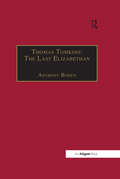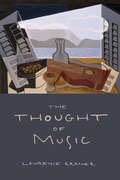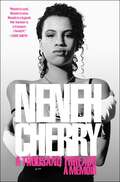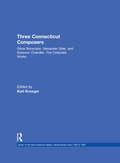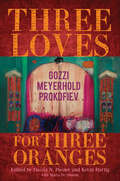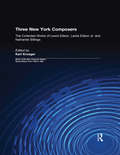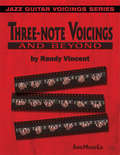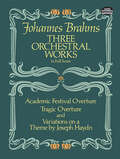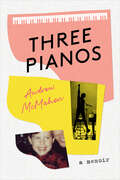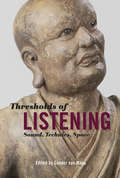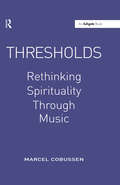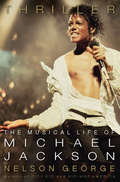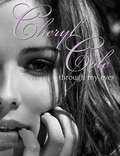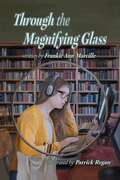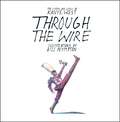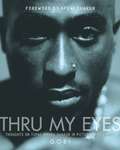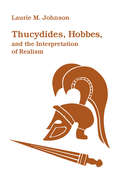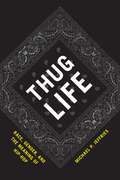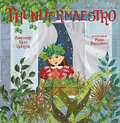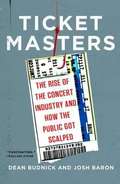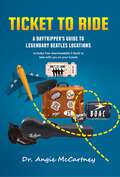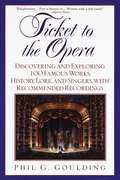- Table View
- List View
Thomas Tomkins: The Last Elizabethan
by Anthony Boden Denis Stevens Bernard Rose Peter James David R.A. EvansThomas Tomkins (1572-1656), a major figure of the Golden Age of British music, was arguably the greatest of all Welsh-born composers. Living through one of the most revolutionary periods in British history, his professional life was spent in the service of the Crown and the Church at both the Chapel Royal and Worcester Cathedral. Surviving the Civil War, the suppression of the music of the English Church, the closure of the Chapel Royal, the destruction of his organ at Worcester and the devastation of the city, Tomkins was able to find the strength and inspiration to continue composing secular music of fine quality. Much of Tomkins's output has survived, including his collection of music for the Anglican rite, Musica Deo Sacra, published posthumously in 1668. His work embraced both sacred and secular vocal music, pieces for keyboard and for viol consort, thereby proving him to be one of the most versatile figures of English Renaissance music. The first part of the book provides an absorbing biography of Tomkins, setting his life into fascinating historical context. The second and third parts include major essays on Tomkins by Denis Stevens, Bernard Rose, Peter James and David Evans, all authorities on the music of the period with each providing perceptive insights into Tomkins's music. The result is a successful piece of collective work that properly places Tomkins and his achievements in his time and enables readers to reassess him properly in relation to his elders and contemporaries. Tomkins has still not reached the 'household name' status of his great teacher, William Byrd, or of his close friend and colleague, Orlando Gibbons, but he is undoubtedly worthy of much greater recognition. The book complements the increasing number of live performances and recordings of Tomkins's music, both sacred and secular, and such a comprehensive account of the man and his work should appeal to early music scholars, performers and music lovers alike.
The Thought of Music
by Lawrence KramerWhat, exactly, is knowledge of music? And what does it tell us about humanistic knowledge in general? The Thought of Music grapples directly with these fundamental questions--questions especially compelling at a time when humanistic knowledge is enmeshed in debates about its character and future. In this third volume in a trilogy on musical understanding that includes Interpreting Music and Expression and Truth, Lawrence Kramer seeks answers in both thought about music and thought in music--thinking in tones. He skillfully assesses musical scholarship in the aftermath of critical musicology and musical hermeneutics and in view of more recent concerns with embodiment, affect, and performance. This authoritative and timely work challenges the prevailing conceptions of every topic it addresses: language, context, and culture; pleasure and performance; and, through music, the foundations of understanding in the humanities.
A Thousand Threads: A Memoir
by Neneh Cherry*Named a Most Anticipated Book by New York magazine, The Associated Press, Town and Country, The Guardian, The BBC, and more* A vibrant memoir from Grammy-nominated singer-songwriter Neneh Cherry who shares an inside look at her fascinating career and globe-traversing journeys in a life of love and music. Born in Sweden in 1964, Neneh Cherry&’s father Ahmadu was a musician from Sierra Leone. Her mother, Moki, was a twenty-one-year-old Swedish textile artist. Her parents split up just after Neneh was born, and not long afterwards Moki met and fell in love with acclaimed jazz musician Don Cherry. Eventually, the strong pull New York City in the 1970s drew him them there, but they made a home wherever they traveled. Neneh and her brother Eagle-Eye experienced a life of creativity, freedom, and, of course, music. In A Thousand Threads, Neneh takes readers from the charming old schoolhouse in the woods of Sweden where she grew up, to the village in Sierra Leone that was birthplace of her biological father, to the early punk scene in London and New York, to finding her identity with her stepfather&’s family in Watts, California. Neneh has lived an extraordinary life of connectivity and creativity and she recounts in intimate detail how she burst onto the scene as a teenager in the punk band The Slits, and went on to release her first album in 1989 with a worldwide hit single &“Buffalo Stance.&” Neneh&’s inspiring and deeply compelling memoir both celebrates female empowerment and shines a light on the global music scene—and is perfect for anyone interested in the artistic life in all its forms.
Three Connecticut Composers: Oliver Brownson, Alexander Gillet, and Solomon Chandler: The Collected Works (Music of the New American Nation: Sacred Music from 1780 to 1820)
by Karl KroegerFirst Published in 1997. Routledge is an imprint of Taylor & Francis, an informa company.
Three Dog Nightmare: The Chuck Negron Story
by Chuck Negron Chris BlatchfordThe former lead singer for Three Dog Night relates his unhappy childhood, his life as a rock star, the drug addiction that nearly killed him, and his final success at getting sober
Three Loves for Three Oranges: Gozzi, Meyerhold, Prokofiev (Russian Music Studies)
by Caryl Emerson Alberto Beniscelli Giulietta Bazoli Domenico Pietropaolo Ted Emery Natalya Baldyga Raissa Raskina Vadim Shcherbakov Laurence Senelick Julia Galanina Inna Naroditskaya Natalia Savkina Simon A. Morrison John E. BowltIn 1921, Sergei Prokofiev's Love for Three Oranges—one of the earliest, most famous examples of modernist opera—premiered in Chicago. Prokofiev's source was a 1913 theatrical divertissement by Vsevolod Meyerhold, who, in turn, took inspiration from Carlo Gozzi's 1761 commedia dell'arte–infused theatrical fairy tale. Only by examining these whimsical, provocative works together can we understand the full significance of their intertwined lineage. With contributions from 17 distinguished scholars in theater, art history, Italian, Slavic studies, and musicology, Three Loves for Three Oranges: Gozzi, Meyerhold, Prokofiev illuminates the historical development of Modernism in the arts, the ways in which commedia dell'arte's self-referential and improvisatory elements have inspired theater and music innovations, and how polemical playfulness informs creation. A resource for scholars and theater lovers alike, this collection of essays, paired with new translations of Love for Three Oranges, charts the transformations and transpositions that this fantastical tale underwent to provoke theatrical revolutions that still reverberate today.
Three New York Composers: The Collected Works of Lewis Edson, Lewis Edson Jr, and Nathaniel Billings (Music of the New American Nation: Sacred Music from 1780 to 1820 #Vol. 3)
by Karl KroegerPart of the Music of the NEW AMERICAN NATION Sacred Music From 1780 To 1820 series. The collected works of Lewis Edson (1748-1820) Lewis Edson Jr. (1771-1845) and Nathaniel Billings (fl. 1794-1795
Three-Note Voicings and Beyond
by Randy VincentRandy Vincent's second Sher Music Co. book covers every aspect of the crucial three-note voicings every guitarist needs to know. It has received glowing endorsements from Pat Metheny, Jim Hall, Mike Stern, Ben Monder, Vic Juris, Gene Bertoncinni, Julian Lage, etc. Three-Note Voicings and Beyond is for everyone from intermediate newcomers to jazz guitar to very advanced players. The book develops a unique dynamic concept of harmony where three independently moving lines team up to create beautiful harmonies that are valuable for comping, chord melodies and chordal jazz improvisations. Topics include: Three-note shell voicings and special derived comp voicings Compete triad review including all close and open inversions on all strings A section on developing walking guitar voicings, harmonized bass lines perfect for accompaniments in situations where no bass or keyboard is present Sections on triad applications such as slash chords, upper structures, hexatonic triad-pairs and special hybrid voicings Quartal and secundal voicings perfect for modal comping and soloing Drop-2 reductions perfect for melody harmonizations A complete method to develop a realistic simulation of Shearing-style block-chord voicings on guitar. Plus much more!
Three Orchestral Works in Full Score: Academic Festival Overture, Tragic Overture and Variations on a Theme by Joseph Haydn
by Johannes BrahmsJohannes Brahms was one of music's greatest masters of classical forms, a composer whose individuality expanded and enriched those forms, giving them new variety of mood and a freshness of melodic invention. In writing for the orchestra, Brahms's independent approach brought unusual dramatic power and intensity to his compositions. Those qualities are strikingly evident in three of the most popular and most frequently performed works in the orchestral repertoire, reproduced here in full score: Academic Festival Overture, Tragic Overture, and Variations on a Theme by Joseph Haydn.This volume reprints, complete and unabridged, the scores of all three orchestral works from the authoritative Breitkopf & Härtel edition, still considered the standard source for the music of Brahms. Included is a new English translation of the Editor's Commentary, which also appears in the original German.The Academic Festival Overture, built upon German student songs, is, according to Grove's Dictionary of Music and Musicians, "a very successful and individual pièce de circonstance," while the Tragic Overture is described as "a gloomy and impressive movement, full of that peculiar sense of foreboding that so many composers ... have associated with the key of D minor." Variations on a Theme by Joseph Haydn is renowned for its spontaneity, melodic invention, and delightfully varied orchestral coloring.Students, composers, and musicologists will find the handy, inexpensive volume of Brahms's great orchestral favorites a valuable addition to their music libraries and an indispensable reference.
Three Pianos: A Memoir
by Andrew McMahonFrom beloved indie musician Andrew McMahon comes a searingly honest and beautifully written memoir about the challenges and triumphs of his life and career, as seen through the lens of his personal connection to three pianos.Andrew McMahon grew up in sunny Southern California as a child prodigy, learning to play piano and write songs at a very early age, stunning schoolmates and teachers alike with his gift for performing and his unique ability to emotionally connect with audiences. McMahon would go on to become the lead singer and songwriter for Something Corporate and Jack's Mannequin, and to release his debut solo album, Andrew McMahon in the Wilderness, in 2014.But behind this seemingly optimistic and quintessentially American story of big dreams come true lies a backdrop of overwhelming challenges that McMahon has faced—from a childhood defined by his father's struggle with addiction to his very public battle with leukemia in 2005 at the age of twenty-three, as chronicled in the intensely personal documentary Dear Jack.Overcoming those odds, McMahon has found solace and hope in the things that matter most, including family, the healing power of music and the one instrument he's always turned to: his piano. Three Pianos takes readers on a beautifully rendered and bitter-sweet American journey, one filled with inspiration, heartbreak, and an unwavering commitment to shedding our past in order to create a better future.
Three Songs, Three Singers, Three Nations
by Greil MarcusGreil Marcus delves into three distinct episodes in the history of American commonplace song and shows how each one manages to convey the uncanny sense that it was written by no one. In these seemingly anonymous productions, we discover three different ways of talking about the United States, and three separate nations within its borders.
Thresholds of Listening: Sound, Technics, Space
by Sander Van MaasThresholds of Listening addresses recent and historical changes in the ways listening has been conceived. Listening, having been emancipated from the passive, subjected position of reception, has come to be asserted as an active force in culture and in collective and individual politics.The contributors to this volume show that the exteriorization of listening— brought into relief by recent historical studies of technologies of listening—involves a re-negotiation of the theoretical and pragmatic distinctions that underpin the notion of listening. Focusing on the manifold borderlines between listening and its erstwhile others, such as speaking, reading, touching, seeing, or hearing, the book maps new frontiers in the history of aurality. They suggest that listening’s finitude— defined in some of the essays as its death or deadliness—should be considered as a heuristic instrument rather than as a mere descriptor.Listening emerges where it appears to end or to run up against thresholds and limits—or when it takes unexpected turns. Listening’s recent emergence on the cultural and theoretical scene may therefore be productively read against contemporary recurrences of the motifs of elusiveness, finitude, and resistance to open up new politics, discourses, and technologies of aurality.
Thresholds: Rethinking Spirituality Through Music
by Marcel CobussenIn Thresholds Marcel Cobussen rethinks the relationship between music and spirituality. The point of departure is the current movement within contemporary classical music known as New Spiritual Music, with as its main representatives Arvo P John Tavener, and Giya Kancheli. In almost all respects, the musical principles of the new spiritual music seem to be diametrically opposed to those of modernism: repetition and rest versus development and progress, tradition and familiarity versus innovation and experiment, communication versus individualism and conceptualism, tonality versus atonality, and so on. As such, this movement is often considered as part of the much larger complex called postmodernism. Joining in with ideas on spirituality as presented by Michel de Certeau and Mark C. Taylor, Cobussen deconstructs the classification of the 'spiritual dimensions' of music as described above. Thresholds presents an idea of spirituality in and through music that counters strategies of exclusion and mastering of alterity and connects it to wandering, erring, and roving. Using the philosophy of Martin Heidegger, Georges Bataille, Jean-Fran‘s Lyotard, Jacques Derrida and others, and analysing the music of John Coltrane, the mythical Sirens, Arvo P and The Eagles (to mention a few), Cobussen regards spirituality as a (non)concept that escapes categorization, classification, and linguistic descriptions. Spirituality is a-topological, non-discursive and a manifestation of 'otherness'. And it is precisely music (or better: listening to music) that induces these thoughts: by carefully encountering, analysing, and evaluating certain examples from classical, jazz, pop and world music it is possible to detach spirituality from concepts of otherworldliness and transcendentalism. Thresholds opens a space in which spirituality can be connected to music that is not commonly considered in this light, thereby enriching the ways of approaching and discussing music. In orde
Thriller: The Musical Life of Michael Jackson
by Nelson GeorgeThriller takes us back to a time in 1982 when Michael Jackson was king of the charts, breaking the color barrier on MTV, heralding the age of video, and becoming the ultimate representation of the crossover dreams of Motown’s Berry Gordy, who helped launch Jackson’s career with the Jackson 5. In this incisive and revealing examination of the making and meaning of Thriller, Nelson George illuminates the brilliant creative process (and work ethic) of Jackson and producer Quincy Jones, deftly exploring the larger context of the music, life, and seismic impact of Michael Jackson on three generations. All this from a groundbreaking journalist and cultural critic who was there. George questions whether the phenomenon Jackson became is even possible today. He revisits his early writings on the King of Pop and examines not only the stunning success of Thriller but also Jackson as an artist, public figure, and racial enigma-including the details surrounding his death on June 25, 2009.
Through My Eyes
by Cheryl ColeThrough My Eyes is the first official book from Cheryl Cole. Featuring a series of stunning exclusive new photos plus informal shots from her own personal collection, it gives us a unique glimpse into the life of our favourite star.From the recording studio in LA as she works on her debut album to backstage in Dublin on the opening night of her tour with the Black Eyed Peas, Cheryl shares with us some of her stand-out moments as a solo artist. We also explore the other elements of her stratospherically successful career as she takes us behind the scenes at The X Factor, into the world of L'Oreal, through the music industry's top awards ceremonies and into the windswept desert in California for a spectacular shoot under freezing conditions where we see her taking time off and enjoying rare moments of anonymity. Through the pictures that mean the most to her and their stories, which are told in her own words, Through My Eyes is a revealing and intimate portrait of the world of Cheryl Cole.
Through the Eye of the Tiger: The Rock n' Roll Life of Survivor's Founding Member
by Jim Peterik Lisa Torem"Hey, yo, Jim . . . This is Sylvester Stallone. Give me a call . . ." It was these words that would set Jim Peterik on the road to rock 'n' roll immortality. After he and his Survivor bandmates recorded "Eye of the Tiger" for the Rocky III soundtrack, the song would go on to earn a Grammy, an Oscar nomination, reach triple platinum status—and become one of the most recognizable tunes in music history. But there's much more to the story of Survivor and its founding member, Jim Peterik, than meets the eye. As one of the most prolific songwriters of his generation, Peterik has cowritten songs with some of the most famous bands and artists of our time, including 38 Special ("Caught Up in You," "Hold on Loosely"), Sammy Hagar ("Heavy Metal"), The Beach Boys, The Doobie Brothers, REO Speedwagon, Cheap Trick, and many more. Now, for the first time, Peterik is sharing his stories. Filled with tales from Peterik's life in rock 'n' roll, Through the Eye of the Tiger documents his early days of success with The Ides of March ("Vehicle"), through the often torturous power struggles within Survivor, and the giddy highs that accompany a trail of worldwide hits. From going to a party in Led Zeppelin's hotel room (and turning right back out the door) to escorting a disoriented Janis Joplin back to her hotel room after opening her show in Calgary, Peterik's accounts will surprise and delight. Through the Eye of the Tiger is more than just a memoir of a songwriting legend; it's a classic rock 'n' roll story told through the eyes of someone who has lived through it all—and through the Eye of the Tiger.
Through the Magnifying Glass
by Frankie Ann Marcille Patrick ReganJulia is just your average middle schooler. She loves spending time with her family and friends, reading, and listening to music or podcasts. She especially loves listening to old-school Sherlock Holmes radio shows on YouTube. But Julia doesn't feel like everyone else. Having a vision impairment sometimes makes her feel like she doesn't fit in anywhere. She's not totally blind, but she's not sighted either. Her family and teachers for the blind encourage her to use adaptive devices, like a white cane, or assistive technology, like a screen reader, to help her, but Julia has no interest. She wants to be just like everyone else, specifically her older brother, John, the town hero, most popular guy in high school, mystery-solving, John.
Through the Wire: Lyrics & Illuminations
by Kanye WestThis is a rare partnership between two geniuses at the top of their crafts -- Kanye West, who was named "the smartest man in hip-hop" by Time magazine, and Bill Plympton, an Academy Award-nominated animator, cartoonist, and illustrator. Through the Wire is a graphic memoir that illustrates the lyrics of twelve Kanye West songs to tell his story, from his decision to drop out of college to pursue his dreams in music, through his days spent folding chinos at the Gap while struggling at night to make a name as a producer, through the pivotal car accident that eventually set him on the course to stardom and the epiphany of realizing exactly who he had become: "...They say people in your life are like seasons And anything that happens is for a reason..." Plympton illustrates each of the songs in detail, his vision of Kanye's world. The songs are annotated with explanations of the references in the songs, biographical components that illuminate the lyrics, and their meaning on a deeply personal level. The result is a one-of-a-kind book that initially grabs you and stays with you forever.
Thru My Eyes: Thoughts on Tupac Amaru Shakur in Pictures and Words
by Gobi"[Tupac] was more than just a black man or an American, he was prophetic," Gobi writes in the foreword to this celebration of the life and legend of Tupac Shakur. Gobi, a fellow artist and friend, reflects on the last year of the hip-hop legend, recording artist, and actor's life in words and images. He takes us from the moment he met Tupac at his house in a water-gun fight to when he stood beside his deathbed in a Los Angeles hospital. Tupac Shakur was charismatic in life, strikingly beautiful on film, and extraordinarily talented whether the medium was movies, music, or words on paper. With intimate photographs and poignant but light-hearted prose, Gobi has created a fascinating portrait revealing the hip-hop icon's many moods, his moments of introspection, and his humor. We see Shakur clowning around -- dressed up as Rick James. We see him as a lover. We see him with children, and as a mythical Egyptian king.
Thucydides, Hobbes, and the Interpretation of Realism
by Laurie M. JohnsonThis original book has been consistently cited by scholars of international relations who explore the roots of realism in Thucydides's history and the political philosophy of Thomas Hobbes. While acknowledging that neither thinker fits perfectly within the confines of international relations realism, Laurie M. Johnson proposes Hobbes's philosophy is more closely aligned with it than Thucydides's.
Thug Life: Race, Gender, and the Meaning of Hip-Hop
by Michael P. JeffriesHip-hop has come a long way from its origins in the Bronx in the 1970s, when rapping and DJing were just part of a lively, decidedly local scene that also venerated b-boying and graffiti. Now hip-hop is a global phenomenon and, in the United States, a massively successful corporate enterprise predominantly controlled and consumed by whites while the most prominent performers are black. How does this shift in racial dynamics affect our understanding of contemporary hip-hop, especially when the music perpetuates stereotypes of black men? Do black listeners interpret hip-hop differently from white fans? These questions have dogged hip-hop for decades, but unlike most pundits, Michael P. Jeffries finds answers by interviewing everyday people. Instead of turning to performers or media critics, " Thug Life" focuses on the musicOCOs fansOCoyoung men, both black and whiteOCoand the resulting account avoids romanticism, offering an unbiased examination of how hip-hop works in peopleOCOs daily lives. As Jeffries weaves the fansOCO voices together with his own sophisticated analysis, we are able to understand hip-hop as a tool listeners use to make sense of themselves and society as well as a rich, self-contained world containing politics and pleasure, virtue and vice. "
Thundermaestro
by Annemarie Riley GuertinRumble, grumble, groan, growl, whoosh, swoosh, creak, squeak, tip tap, pitter-patter, splitter, splatter. The crescendo builds. With baton in hand, a little girl conducts a majestic symphony with the sounds of a summer rainstorm. The whoosh of wind and the toccata of raindrops make a grand concert. With gorgeous mixed-media illustrations that juxtapose the gathering storm outside with the music inside the girl&’s imagination, this celebration of the music of nature will leave readers breathless until the final bow.
Ticket Masters: The Rise of the Concert Industry and How the Public Got Scalped
by Dean Budnick Josh Baron“A clear, comprehensive look at a murky business. ” —The Wall Street Journal Your favorite band has just announced their nationwide tour. Should you pay to join their fan club and get in on the pre-sale? No, you decide to wait. But the on-sale date arrives, and the site is jammed. You can’t get on—and the concert is sold out in six minutes. What happened? What now? Music journalists Dean Budnick and Josh Baron chronicle the behind-the-scenes history of the modern concert industry. Filled with entertaining rock-and-roll anecdotes about The Rolling Stones, The Grateful Dead, Pearl Jam, and more—and charting the emergence of players like Ticketmaster, StubHub, Live Nation, and Outbox—Ticket Masters will transfix every concertgoer who wonders just where the price of admission really goes. This edition has an updated epilogue that covers recent industry developments. .
Ticket to Ride: Legendary Beatle Locations For The Day Tripper
by Angie McCartneyAngie McCartney was part of the inner circle of Fab Fourdom in Liverpool in the '60s, and as the step-mother to Sir Paul she has had many interactions with rockstars and royalty, pop stars and presidents, and they all have one thing in common... they're Beatle fans. Now that Beatle Tourism is a burgeoning industry, Angie's travel-size book takes you down memory lane to Penny Lane and 85+ other points of interest on the long and winding road. You'll be directed to spots in the Mop Top maps of Liverpool, London, Hamburg, New York and Los Angeles, you'll discover nuggets and stories to satisfy the day tripper in you! The book also features SmartBook® technology from McCartney Multimedia, and by scanning the QR codes with your smart-phone, you'll be transported to a destination of fascination online, with links to tours, maps, trivia, videos, much more information than we can fit in a postcard sized book, and a deeper dive into these tourist locations and their magical history. We hope you travel safely and create memories for a lifetime as in these legendary locations, a splendid time is guaranteed for all.
Ticket to the Opera: Discovering and Exploring 100 Famous Works, History, Lore, and Singers, with Rec
by Phil G. GouldingIn Ticket to the Opera, Phil G. Goulding finally makes the magic and mystique of opera accessible to all. Here he offers a complete operatic education, including history, definitions of key musical terms, opera lore and gossip, portraits of famous singers and the roles they immortalized, as well as pithy introductions to the greatest operas of Europe and America and their composers. The book's centerpiece is what Goulding terms "the collection"--85 classics, among them Aida, The Marriage of Figaro, Carmen, and Madama Butterfly, that have been packing the world's opera houses for years. This entertaining, meticulously researched book also includes a fascinating chapter on American opera from George Gershwin's Porgy and Bess to Philip Glass's Einstein on the Beach and a discussion of the gems of twentieth-century opera featuring works like Leos Janácek's The Cunning Little Vixen, Alban Berg's Lulu, and Serge Prokofiev's The Love for Three Oranges.Whether you're a curious neophyte, a music lover interested in branching out, or an aficionado eager to compare notes with a brilliant fellow opera buff, you'll prize Ticket to the Opera as an essential volume in your music library.From the Trade Paperback edition.
